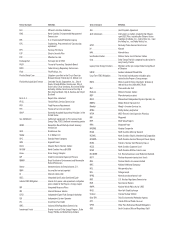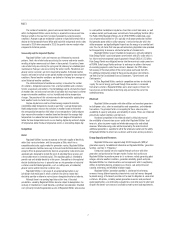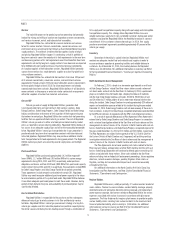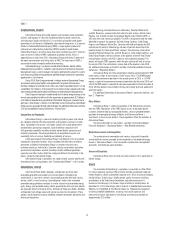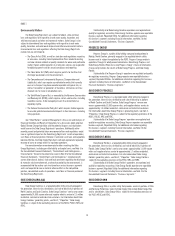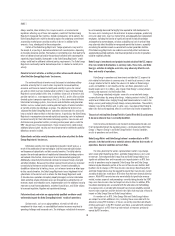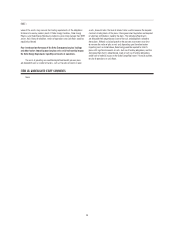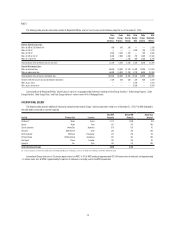Duke Energy 2014 Annual Report Download - page 34
Download and view the complete annual report
Please find page 34 of the 2014 Duke Energy annual report below. You can navigate through the pages in the report by either clicking on the pages listed below, or by using the keyword search tool below to find specific information within the annual report.
PART I
14
Environmental Matters
The Duke Energy Registrants are subject to federal, state and local
laws and regulations with regard to air and water quality, hazardous and
solid waste disposal and other environmental matters. Duke Energy is also
subject to international laws and regulations with regard to air and water
quality, hazardous and solid waste disposal and other environmental matters.
Environmental laws and regulations affecting the Duke Energy Registrants
include, but are not limited to:
• The Clean Air Act (CAA), as well as state laws and regulations impacting
air emissions, including State Implementation Plans related to existing
and new national ambient air quality standards for ozone and particulate
matter. Owners and/or operators of air emission sources are responsible
for obtaining permits and for annual compliance and reporting.
• The Clean Water Act (CWA) which requires permits for facilities that
discharge wastewaters into the environment.
• The Comprehensive Environmental Response, Compensation and
Liability Act, which can require any individual or entity that currently
owns or in the past may have owned or operated a disposal site, as
well as transporters or generators of hazardous substances sent to a
disposal site, to share in remediation costs.
• The Solid Waste Disposal Act, as amended by the Resource Conservation
and Recovery Act (RCRA), which requires certain solid wastes, including
hazardous wastes, to be managed pursuant to a comprehensive
regulatory regime.
• The National Environmental Policy Act, which requires federal agencies
to consider potential environmental impacts in their decisions, including
siting approvals.
See “Other Matters” section of Management’s Discussion and Analysis of
Financial Condition and Results of Operations for a discussion about potential
Global Climate Change legislation and the potential impacts such legislation
could have on the Duke Energy Registrants’ operations. Additionally, other
recently passed and potential future environmental laws and regulations could
have a signifi cant impact on the Duke Energy Registrants’ results of operations,
cash fl ows or fi nancial position. However, if and when such laws and regulations
become effective, the Duke Energy Registrants will seek appropriate regulatory
recovery of costs to comply within its regulated operations.
For more information on environmental matters involving the Duke
Energy Registrants, including possible liability and capital costs, see Note 5 to
the Consolidated Financial Statements, “Commitments and Contingencies –
Environmental.” Except to the extent discussed in Note 5 to the Consolidated
Financial Statements, “Commitments and Contingencies,” compliance with
current international, federal, state and local provisions regulating the discharge
of materials into the environment, or otherwise protecting the environment, is
incorporated into the routine cost structure of our various business segments
and is not expected to have a material adverse effect on the competitive
position, consolidated results of operations, cash fl ows or fi nancial position of
the Duke Energy Registrants.
DUKE ENERGY CAROLINAS
Duke Energy Carolinas is a regulated public utility primarily engaged in
the generation, transmission, distribution, and sale of electricity in portions of
North Carolina and South Carolina. Duke Energy Carolinas’ service area covers
approximately 24,000 square miles and supplies electric service to 2.5 million
residential, commercial and industrial customers. For information about Duke
Energy Carolinas’ generating plants, see Item 2, “Properties.” Duke Energy
Carolinas is subject to the regulatory provisions of the NCUC, PSCSC, NRC and
FERC.
Substantially all of Duke Energy Carolinas operations are regulated and
qualify for regulatory accounting. Duke Energy Carolinas operates one reportable
business segment, Regulated Utility. For additional information regarding
this business segment, including fi nancial information, see Note 3 to the
Consolidated Financial Statements, “Business Segments.”
PROGRESS ENERGY
Progress Energy is a public utility holding company headquartered in
Raleigh, North Carolina, primarily engaged in the regulated electric utility
business and is subject to regulation by the FERC. Progress Energy conducts
operations through its wholly owned subsidiaries, Duke Energy Progress and
Duke Energy Florida. When discussing Progress Energy’s fi nancial information,
it necessarily includes the results of Duke Energy Progress and Duke Energy
Florida.
Substantially all of Progress Energy’s operations are regulated and qualify
for regulatory accounting. Progress Energy operates one reportable business
segment, Regulated Utilities. For additional information regarding this business
segment, including fi nancial information, see Note 3 to the Consolidated
Financial Statements, “Business Segments.”
DUKE ENERGY PROGRESS
Duke Energy Progress is a regulated public utility primarily engaged in
the generation, transmission, distribution and sale of electricity in portions
of North Carolina and South Carolina. Duke Energy Progress’ service area
covers approximately 32,000 square miles, and supplies electric service to
approximately 1.5 million residential, commercial and industrial customers.
For information about Duke Energy Progress’ generating plants, see Item 2,
“Properties.” Duke Energy Progress is subject to the regulatory provisions of the
NCUC, PSCSC, NRC and FERC.
Substantially all of Duke Energy Progress’ operations are regulated and
qualify for regulatory accounting. Duke Energy Progress operates one reportable
business segment, Regulated Utility. For additional information regarding
this business segment, including fi nancial information, see Note 3 to the
Consolidated Financial Statements, “Business Segments.”
DUKE ENERGY FLORIDA
Duke Energy Florida is a regulated public utility primarily engaged in
the generation, transmission, distribution, and sale of electricity in portions of
Florida. Duke Energy Florida’s service area covers approximately 13,000 square
miles and supplies electric service to approximately 1.7 million residential,
commercial and industrial customers. For information about Duke Energy
Florida’s generating plants, see Item 2, “Properties.” Duke Energy Florida is
subject to the regulatory provisions of the FPSC, NRC and FERC.
Substantially all of Duke Energy Florida’s operations are regulated and
qualify for regulatory accounting. Duke Energy Florida operates one reportable
business segment, Regulated Utility. For additional information regarding
this business segment, including fi nancial information, see Note 3 to the
Consolidated Financial Statements, “Business Segments.”
DUKE ENERGY OHIO
Duke Energy Ohio is a public utility that provides service in portions of Ohio
and Kentucky. References herein to Duke Energy Ohio include Duke Energy Ohio
and its subsidiaries. Duke Energy Ohio is subject to the regulatory provisions of
the PUCO, KPSC and FERC.


